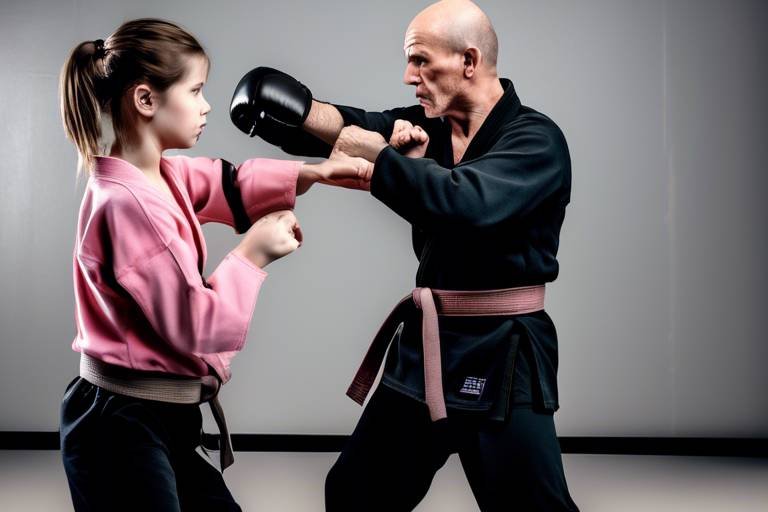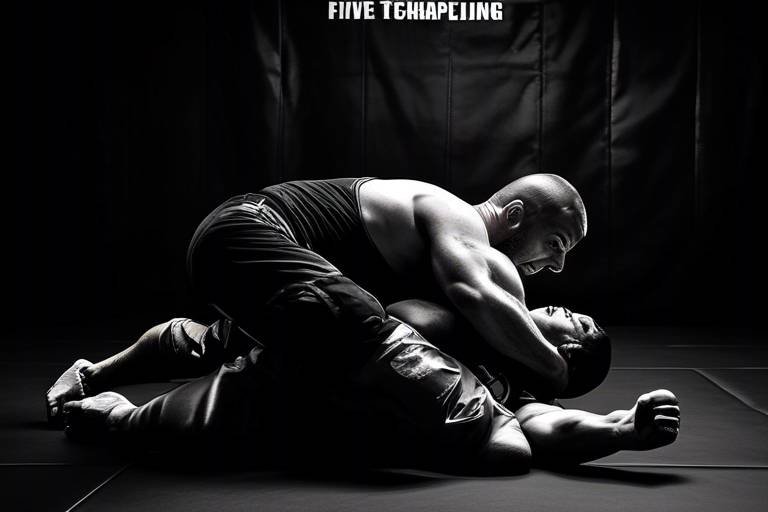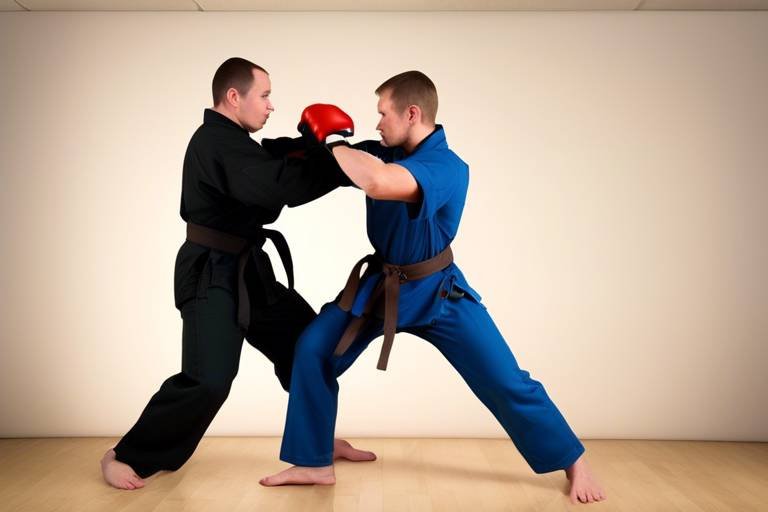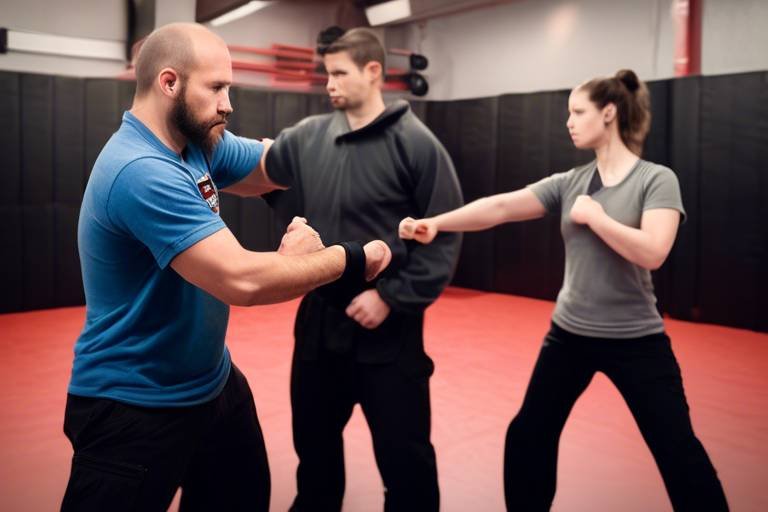How Aikido Teaches Non-Aggression and Respect through Self-Defense Techniques
Aikido is not just a martial art; it’s a philosophy that embodies the essence of non-aggression and respect. Imagine a world where conflicts are resolved not through violence, but through understanding and harmony. That’s precisely what Aikido aims to achieve. In this article, we will explore how Aikido’s unique approach to self-defense techniques fosters a peaceful mindset while empowering individuals to defend themselves effectively. By embracing the principles of Aikido, practitioners learn to navigate confrontations with grace and poise, turning potential conflicts into opportunities for personal growth.
The philosophy behind Aikido is deeply rooted in the concepts of harmony and respect. Unlike many martial arts that focus primarily on defeating an opponent, Aikido encourages practitioners to seek resolution without resorting to violence. This fundamental belief is what sets Aikido apart. It teaches that true strength lies not in dominating others, but in understanding and redirecting the energy of conflict. Aikido practitioners learn to see their opponents not as adversaries, but as partners in a dance of mutual respect. This mindset fosters an environment where personal growth and self-discovery can flourish.
At the heart of Aikido is the principle of non-aggression. This tenet is crucial, as it shapes not only the way practitioners train but also how they interact with others in daily life. In Aikido, non-aggression doesn’t mean avoiding conflict altogether; rather, it means approaching confrontations with a calm and peaceful mindset. This allows practitioners to defend themselves without escalating the situation, which is a valuable skill both on and off the mat. The practice of non-aggression promotes a sense of safety and security, enabling individuals to navigate the complexities of life with confidence.
Aikido equips practitioners with a variety of techniques designed to handle confrontations in a calm and composed manner. One of the most effective methods is the art of redirecting aggression. Instead of meeting force with force, Aikido teaches individuals to use their opponent's energy against them. This principle is not only applicable in the dojo but can also be applied in real-life situations, allowing practitioners to de-escalate potentially violent encounters. By embracing these techniques, individuals learn to transform conflict into a peaceful resolution.
One of the standout features of Aikido is its focus on redirecting energy. Picture this: instead of pushing back against an incoming force, you gently guide it away from you. This principle can be applied in various real-life scenarios, such as when someone confronts you aggressively. By redirecting their energy, you can defuse the situation without confrontation. This technique not only helps in self-defense but also fosters a deeper understanding of human interactions, promoting empathy and connection.
Another critical aspect of Aikido is balance and timing. Mastering these elements is essential for effective conflict resolution. In Aikido, practitioners learn to maintain their own balance while also recognizing the balance of their opponents. This awareness allows them to anticipate movements and respond appropriately. In everyday life, these skills translate to better decision-making and the ability to remain composed under pressure. By honing their balance and timing, Aikido practitioners become adept at navigating challenges with ease.
Respect is a cornerstone of Aikido practice. Within the dojo, mutual respect among practitioners creates a supportive environment conducive to learning and personal growth. This culture of respect fosters camaraderie and encourages individuals to challenge themselves while also lifting each other up. The emphasis on respect extends beyond the training mat; it influences how practitioners interact with others in their daily lives. By cultivating respect, Aikido promotes a sense of community and belonging, nurturing individuals who are not only skilled in self-defense but also compassionate and understanding.
Aikido offers a wide range of self-defense techniques that prioritize control over aggression. The beauty of these techniques lies in their ability to neutralize threats without causing harm. Aikido practitioners learn to use their opponent's force to their advantage, allowing them to effectively subdue an attacker while minimizing injury. This approach not only protects the practitioner but also demonstrates the power of restraint and compassion.
Among the various techniques in Aikido, joint locks and throws are particularly effective in self-defense scenarios. These techniques enable practitioners to immobilize an opponent, rendering them incapable of further aggression. For instance, a simple wrist lock can effectively control an assailant, allowing the practitioner to escape safely. The beauty of these techniques lies in their fluidity and adaptability, making them suitable for individuals of all sizes and strengths.
In Aikido, defensive strategies are designed to avoid conflict while ensuring personal safety. Practitioners learn to assess situations and determine the best course of action. By focusing on awareness and prevention, Aikido teaches individuals to navigate potentially dangerous encounters with confidence. This proactive approach not only enhances personal safety but also instills a sense of empowerment and responsibility.
- What is Aikido? Aikido is a modern Japanese martial art that emphasizes harmony, non-aggression, and self-defense techniques.
- Is Aikido effective for self-defense? Yes, Aikido techniques focus on controlling an opponent without causing harm, making it effective for self-defense.
- Can anyone practice Aikido? Absolutely! Aikido is suitable for individuals of all ages and fitness levels.
- What do I need to start Aikido training? Generally, you’ll need a comfortable training uniform (gi) and a willingness to learn.

Understanding Aikido's Philosophy
Aikido, often referred to as the "Way of Harmony," is not just a martial art; it’s a profound philosophy that seeks to cultivate peace and respect among individuals. At its core, Aikido teaches that true strength lies in the ability to maintain harmony with oneself and others. Instead of promoting aggression or violence, Aikido encourages practitioners to find a balance in their interactions, both on and off the mat. This is achieved through a series of principles that define the essence of Aikido.
One of the central tenets of Aikido is the belief that every conflict can be resolved without resorting to violence. This may sound idealistic, but the techniques taught in Aikido are designed to help practitioners navigate confrontations with grace and composure. Imagine a river flowing around a rock; it doesn’t fight the rock but instead finds a way to continue its course. Similarly, Aikido teaches us to flow with the situation rather than against it, redirecting negative energy and transforming potential conflict into a peaceful resolution.
Another significant aspect of Aikido's philosophy is respect. Respect for oneself, respect for one’s training partners, and respect for one’s opponents are fundamental components of the practice. In the dojo, practitioners bow to each other as a sign of mutual respect before and after each session. This simple act symbolizes an acknowledgment of the shared journey towards self-improvement and mastery. It’s a reminder that every interaction, whether friendly or confrontational, deserves a level of respect.
Aikido also emphasizes the importance of awareness. Practitioners are taught to be fully present in the moment, which enhances their ability to respond to situations effectively. This heightened awareness allows individuals to assess their surroundings and the intentions of others, enabling them to make informed decisions that prioritize safety and harmony. In essence, Aikido encourages us to cultivate a mindset that is both alert and peaceful.
To summarize, Aikido’s philosophy can be encapsulated in the following key principles:
- Harmony: Striving for balance in all interactions.
- Non-aggression: Resolving conflicts without violence.
- Respect: Valuing oneself and others.
- Awareness: Being present and perceptive in every situation.
These principles not only shape the practice of Aikido but also extend into everyday life, influencing how practitioners engage with the world around them. By embracing these values, individuals can foster a more peaceful and respectful environment, ultimately contributing to a more harmonious society.

The Importance of Non-Aggression
Non-aggression is not just a concept in Aikido; it is a fundamental tenet that shapes the entire practice. This philosophy encourages practitioners to view conflict not as a battle to be won, but as an opportunity for understanding and resolution. Imagine walking into a dojo where the atmosphere is charged with mutual respect and a shared commitment to peace. Here, the goal is not to overpower an opponent, but to harmonize with their energy, transforming potential violence into a constructive exchange. This approach fosters a sense of community and trust among practitioners, making the dojo a safe space for personal growth.
In the world outside the dojo, the principles of non-aggression can have a profound impact on our daily interactions. By choosing to respond to aggression with calmness and understanding, we can diffuse tense situations before they escalate. This is especially important in today’s fast-paced society, where conflicts often arise in the blink of an eye. Practicing non-aggression allows individuals to navigate these challenges with grace and confidence, ultimately leading to healthier relationships and a more peaceful environment.
To illustrate the significance of non-aggression in Aikido, consider the following points:
- Promotes Peaceful Resolutions: By prioritizing harmony, Aikido practitioners learn to resolve conflicts without resorting to violence.
- Enhances Communication Skills: Non-aggression encourages open dialogue, allowing individuals to express their feelings and concerns effectively.
- Builds Emotional Intelligence: Practitioners develop the ability to read situations and respond appropriately, which is crucial in conflict resolution.
Moreover, the practice of non-aggression is not limited to the dojo; it extends into our everyday lives. Imagine a scenario where two colleagues have a disagreement. Instead of escalating the situation, one of them applies the principles learned in Aikido, choosing to listen and understand the other’s perspective. This shift in approach not only resolves the conflict but also strengthens their working relationship.
Ultimately, the importance of non-aggression in Aikido lies in its ability to transform individuals into ambassadors of peace. Each practitioner becomes a living example of how to handle conflict with respect and dignity, inspiring those around them to adopt similar attitudes. By embracing non-aggression, we don’t just learn to defend ourselves; we cultivate a culture of respect and understanding that can ripple out into the world. This is the true essence of Aikido—turning the art of self-defense into an art of living harmoniously.
- What is Aikido? Aikido is a Japanese martial art that focuses on self-defense techniques that emphasize harmony and non-aggression.
- How does non-aggression work in Aikido? Non-aggression in Aikido involves redirecting an opponent's energy instead of confronting it directly, promoting peaceful conflict resolution.
- Can Aikido techniques be applied in daily life? Yes, the principles of Aikido can be applied to everyday situations, helping individuals manage conflicts and communicate more effectively.

Conflict Resolution Techniques
In the world of Aikido, conflict resolution is not just about physical techniques; it's a comprehensive approach that integrates mental and emotional aspects. Aikido teaches practitioners to remain calm and centered, even in the face of aggression. This philosophy is rooted in the understanding that every conflict can be an opportunity for growth and learning, rather than a battle to be won. By focusing on non-aggression, Aikido encourages individuals to look beyond the immediate confrontation and seek a peaceful resolution.
One of the most effective conflict resolution techniques in Aikido is the concept of redirecting aggression. Instead of meeting force with force, Aikido practitioners learn to use their opponent's energy against them. This approach not only neutralizes the threat but also minimizes the risk of escalation. For instance, when faced with an aggressive attack, the Aikido practitioner might pivot, allowing the attacker's momentum to carry them off balance. This method is akin to the way a skilled dancer might lead their partner gracefully across the floor, using their movements to create a harmonious flow rather than a jarring collision.
Another essential technique is the emphasis on awareness and observation. Aikido teaches its practitioners to be acutely aware of their surroundings and to read the energy of a situation. This heightened awareness allows them to anticipate potential conflicts before they arise. Imagine walking into a crowded room and sensing the tension in the air; an Aikido practitioner can use this intuition to navigate the environment more effectively, avoiding confrontations altogether.
Additionally, Aikido promotes the use of communication as a powerful tool in conflict resolution. Practitioners are trained to express their intentions clearly and assertively, which can often de-escalate a potentially violent situation. By articulating their thoughts and feelings, Aikido students create an atmosphere of respect and understanding, paving the way for a peaceful resolution. This is similar to how effective negotiation can resolve disputes in business; clear communication can lead to mutual understanding and agreement.
Ultimately, the techniques taught in Aikido are not just applicable on the mat; they extend into everyday life. Whether it's dealing with a heated discussion at work or navigating personal relationships, the principles of Aikido can help individuals manage conflicts with grace and poise. By embracing these techniques, practitioners not only enhance their self-defense skills but also cultivate a mindset of peace and respect that can transform their interactions with others.
- What is the main goal of Aikido? Aikido aims to promote harmony and non-aggression, teaching practitioners to resolve conflicts peacefully.
- Can Aikido techniques be applied in real-life situations? Yes, Aikido techniques focus on redirecting energy and maintaining balance, making them effective in various conflict scenarios.
- Is Aikido suitable for beginners? Absolutely! Aikido welcomes practitioners of all levels, providing a supportive environment to learn and grow.
- How does Aikido differ from other martial arts? Unlike many martial arts that emphasize competition and aggression, Aikido focuses on self-defense and conflict resolution without harming others.

Redirecting Energy
In Aikido, the concept of is not just a technique; it's a philosophy that permeates every aspect of the practice. Imagine standing in front of a wave. Instead of trying to fight against it, you learn to move with it, allowing the wave to pass by while you maintain your balance. This is the essence of redirecting energy in Aikido. When faced with an aggressive opponent, the goal is not to meet force with force but to guide their energy away from you, transforming a potential conflict into a harmonious interaction.
Practitioners are taught to observe the direction and intensity of an attack. By doing so, they can employ techniques that utilize the opponent's momentum against them. For instance, if someone is charging at you, instead of bracing for impact, you might step aside and gently redirect their force, causing them to lose balance and control. This method not only protects you but also minimizes harm to the aggressor, embodying the Aikido principle of non-violence.
To better understand this concept, consider the following techniques commonly used in Aikido to redirect energy:
- Irimi Nage: This technique involves entering into the opponent's space while simultaneously redirecting their energy, often resulting in a throw.
- Tenkan: A pivoting motion that allows the practitioner to turn and redirect the opponent's force, effectively neutralizing the attack.
- Shihonage: By using the opponent’s arm, this technique redirects their energy through a twisting motion, leading to a controlled throw.
Each of these techniques exemplifies how Aikido practitioners can maintain control over a situation without resorting to aggression. The beauty of redirecting energy lies in its simplicity and effectiveness. It teaches us that in life, just as on the mat, we can choose to flow with challenges rather than resist them. This mindset can lead to better conflict resolution in everyday situations, encouraging a more peaceful existence.
In summary, redirecting energy in Aikido is about more than just physical techniques; it's about cultivating a mindset that values harmony over conflict. By learning to guide rather than confront, practitioners not only enhance their self-defense skills but also develop a deeper understanding of respect and non-aggression in all aspects of life.

Using Balance and Timing
In Aikido, the concepts of balance and timing are not just technical skills; they are the very essence of effective self-defense and conflict resolution. Imagine standing on a tightrope, where every shift in your weight could either lead to a graceful performance or a disastrous fall. This is how crucial balance is in Aikido. Practitioners learn to maintain their own balance while also understanding how to disrupt the balance of an opponent. This duality is not just physical; it’s also mental. When you’re balanced, you can think clearly, react quickly, and execute techniques with precision.
Timing, on the other hand, is like the rhythm of a dance. It’s about knowing when to move, when to yield, and when to strike. Aikido teaches that the right moment to respond is often when an opponent is at their most vulnerable—when they are committed to their attack. By practicing techniques that emphasize timing, Aikido students learn to anticipate movements and respond fluidly, creating a harmonious flow that turns potential conflict into a controlled resolution.
To illustrate the importance of balance and timing in Aikido, consider the following aspects:
- Balance: Maintaining a low center of gravity helps practitioners stay grounded, making it harder for an opponent to throw or push them off balance.
- Timing: Recognizing the exact moment to execute a technique can mean the difference between successfully neutralizing a threat and being overpowered.
- Coordination: Combining balance and timing enhances overall coordination, allowing for more fluid movements that can adapt to various situations.
In practice, these elements are intertwined. For instance, when performing a throw, a student must not only apply force but also ensure that their body is aligned correctly, and they are moving at the right moment to maximize effectiveness. This synchronization creates a powerful technique that feels effortless, even against larger or stronger opponents.
Furthermore, balance and timing extend beyond the dojo. In daily life, these principles can help individuals navigate conflicts more smoothly. For example, in a heated discussion, maintaining emotional balance and recognizing the right moment to speak or listen can lead to a more productive outcome. Aikido teaches that these skills are transferable, promoting not just physical self-defense but also emotional resilience.

Respect in Training
In the world of Aikido, respect is not just a formality; it is the very foundation upon which the practice is built. When you step onto the mat, you’re not just engaging in a physical activity; you’re entering a space where mutual respect fosters growth, learning, and community. Every bow, every technique practiced, and every interaction with fellow practitioners is imbued with a sense of honor and appreciation. This respect transcends the dojo and seeps into our daily lives, teaching us to value not just ourselves but also those around us.
At its core, Aikido emphasizes the importance of recognizing the humanity in others. Each practitioner, regardless of skill level, brings something unique to the training environment. This diversity is celebrated, and it’s this very aspect that cultivates a supportive atmosphere. Imagine a circle of students, each contributing their strengths and perspectives, creating a rich tapestry of learning experiences. This collective respect encourages individuals to push their limits while also supporting their peers, creating a powerful synergy that enhances everyone’s journey.
Moreover, the respect shown in training extends to the instructors as well. In Aikido, teachers are not just authority figures; they are mentors who guide practitioners on their paths. Students are encouraged to approach their instructors with humility and openness, ready to absorb knowledge and feedback. This dynamic creates a culture where learning is a shared journey, with respect acting as the glue that binds everyone together.
To illustrate the significance of respect in Aikido training, consider the following key aspects:
- Mutual Learning: Every interaction is an opportunity to learn, whether it's from a senior student or a beginner. Respecting each other's journey enriches the experience.
- Encouragement: Practitioners uplift one another, celebrating successes and providing support during challenges. This camaraderie fosters a safe space for growth.
- Constructive Feedback: Respectful communication allows for honest and constructive feedback, essential for improvement and skill development.
In conclusion, the essence of Aikido training lies in the respect shared among practitioners. This respect not only enhances the learning experience within the dojo but also cultivates a sense of community and understanding that extends beyond the mat. By embracing this philosophy, individuals not only become better martial artists but also better human beings, equipped with the tools to navigate life’s challenges with grace and dignity.
Q: How does respect manifest in Aikido training?
A: Respect is shown through actions like bowing, listening attentively to instructors, and supporting fellow practitioners during their learning process.
Q: Can I practice Aikido if I have no prior martial arts experience?
A: Absolutely! Aikido welcomes individuals of all skill levels, and the respectful environment ensures that everyone can learn at their own pace.
Q: How does the principle of respect in Aikido affect personal development?
A: The practice of respect in Aikido fosters self-discipline, empathy, and improved communication skills, which can positively impact various aspects of life.

Self-Defense Techniques in Aikido
Aikido is not just about physical prowess; it's a holistic approach to self-defense that emphasizes control and respect. Unlike many martial arts that focus on striking or overpowering an opponent, Aikido teaches practitioners to neutralize threats while minimizing harm. This unique philosophy is reflected in its various self-defense techniques, which are designed to protect oneself without resorting to aggression. Imagine being in a situation where someone is trying to attack you. Instead of meeting force with force, Aikido encourages you to redirect that energy, creating a safer outcome for both parties involved.
One of the most notable aspects of Aikido is its use of joint locks and throws. These techniques allow a practitioner to subdue an opponent effectively, using their own movements against them. For instance, when an attacker lunges forward, instead of pushing back, an Aikido practitioner might step aside and apply a joint lock. This not only immobilizes the attacker but also prevents any unnecessary harm. The beauty of these techniques lies in their elegance and efficiency, which can be particularly empowering for individuals of all sizes.
| Technique | Description | Application |
|---|---|---|
| Shihonage | A four-direction throw that uses the opponent's momentum. | Effective against a frontal attack. |
| Ikkyu | A simple wrist lock that can control an opponent. | Useful in close-quarters situations. |
| Kotegaeshi | A technique that involves turning the wrist to throw the opponent. | Can be applied when someone grabs your wrist. |
In addition to joint locks and throws, Aikido practitioners are trained in defensive strategies that focus on avoiding conflict while ensuring safety. These strategies emphasize awareness and de-escalation techniques. For example, if someone approaches you aggressively, instead of standing your ground, Aikido teaches you to assess the situation calmly and respond with a technique that diffuses the tension. This might involve moving to the side or using verbal communication to ease the situation. The goal is to create a safe space for both you and your potential attacker, transforming a potentially violent encounter into a peaceful resolution.
Ultimately, the self-defense techniques in Aikido are not just about physical skills; they are a way of life. They instill a sense of confidence and awareness in practitioners, allowing them to navigate challenging situations with grace and poise. By fostering a mindset of non-aggression and respect, Aikido equips individuals with the tools needed to protect themselves while promoting harmony in their interactions. So, whether you're a seasoned martial artist or just starting out, embracing the principles of Aikido can lead to a more peaceful and empowered existence.
- What makes Aikido different from other martial arts? Aikido focuses on non-aggression and conflict resolution, utilizing techniques that redirect an opponent's energy rather than meeting force with force.
- Can anyone practice Aikido? Yes! Aikido is suitable for individuals of all ages and fitness levels. Its techniques can be adapted to meet the needs of each practitioner.
- How long does it take to learn Aikido? The time it takes to learn Aikido varies by individual, but consistent practice can lead to noticeable improvements within a few months.
- Is Aikido effective for self-defense? Absolutely! Aikido emphasizes control and de-escalation, making it effective for self-defense without causing unnecessary harm.

Joint Locks and Throws
In Aikido, joint locks and throws are not just techniques; they are expressions of the art's philosophy of non-aggression and control. These techniques allow practitioners to neutralize threats while minimizing harm to the aggressor. Imagine being in a situation where someone is trying to overpower you. Instead of meeting force with force, Aikido teaches you to use their energy against them, creating a harmonious resolution to the confrontation.
Joint locks are techniques that manipulate the joints of an opponent, typically the wrist, elbow, or shoulder, to gain control over them. The beauty of these locks lies in their precision and effectiveness. For example, the ikkyo technique involves controlling the opponent's arm by applying pressure to their wrist, which can effectively immobilize them. The key here is to maintain a calm demeanor and focus on balance rather than brute strength. This approach not only protects you but also transforms a potentially violent encounter into a controlled situation.
Throws, on the other hand, are designed to unbalance an opponent and take them to the ground. Techniques such as iriminage and shihonage exemplify how Aikido practitioners can use an opponent's momentum to execute a throw. In iriminage, for instance, the practitioner steps into the opponent's space, redirecting their energy and leading them into a throw. This technique is a perfect illustration of the Aikido principle of redirecting energy, allowing you to maintain control without resorting to aggression.
When it comes to applying these techniques in real-life situations, the principles of balance and timing are crucial. A practitioner must be aware of their own center of gravity while also being attuned to their opponent's movements. By mastering these elements, you can effectively execute joint locks and throws, ensuring that you remain safe while neutralizing a potential threat.
To further illustrate the effectiveness of joint locks and throws in Aikido, let’s take a look at a comparison of various techniques:
| Technique | Type | Description |
|---|---|---|
| Ikkyo | Joint Lock | Controls the opponent's wrist and arm, immobilizing them. |
| Iriminage | Throw | Steps into the opponent's space to redirect their energy into a throw. |
| Shihonage | Throw | Uses the opponent's momentum to execute a four-directional throw. |
In conclusion, joint locks and throws in Aikido are not merely physical maneuvers; they embody a philosophy of respect and non-aggression. By learning and practicing these techniques, practitioners not only enhance their self-defense skills but also cultivate a deeper understanding of conflict resolution that can be applied in everyday life.

Defensive Strategies
When it comes to self-defense, Aikido stands out by emphasizing strategies that prioritize avoidance and de-escalation over confrontation. This approach is not just about physical techniques but also about cultivating a mindset that values peace and safety. Imagine walking through a bustling city and sensing tension in the air; instead of engaging in a potential conflict, an Aikido practitioner would utilize their training to navigate the situation smoothly, maintaining composure and respect for all involved.
One of the primary defensive strategies in Aikido is the concept of awareness. Practitioners are trained to be acutely aware of their surroundings, allowing them to anticipate potential threats before they escalate. This heightened awareness is akin to a chess player who can see several moves ahead, enabling them to avoid checkmate. By recognizing the signs of aggression early on, Aikido students can choose to remove themselves from harmful situations, effectively practicing the art of retreating without losing face.
Another essential strategy is the use of verbal de-escalation. In many cases, conflicts can be diffused through calm and respectful communication. Aikido teaches practitioners to maintain a serene demeanor and to use their words to defuse tension. Picture a scenario where two individuals are on the verge of a fight; an Aikido practitioner might step in, using a soft voice and open body language to encourage dialogue rather than aggression. This not only helps to cool tempers but also fosters an environment of respect and understanding.
In addition to awareness and verbal skills, Aikido emphasizes the importance of body positioning. By maintaining a balanced stance and positioning oneself strategically, a practitioner can effectively manage confrontations. This concept can be illustrated through the idea of a tree in a storm; a strong tree bends with the wind rather than breaking. Similarly, in a conflict, an Aikido practitioner remains flexible and adaptable, allowing them to respond to an aggressor’s movements without escalating the situation.
Moreover, Aikido’s techniques often include redirecting energy rather than meeting force with force. For instance, if someone were to push you, instead of pushing back, an Aikido practitioner would sidestep and guide that energy away. This principle not only minimizes harm but also exemplifies the philosophy of non-aggression that Aikido embodies. By practicing these techniques regularly, practitioners develop a sense of confidence that allows them to handle confrontations with grace and composure.
Finally, it’s crucial to understand that Aikido encourages practitioners to seek out peaceful resolutions. This is not merely about physical techniques but also about cultivating a mindset geared towards harmony. In practice, this means that every Aikido session becomes a lesson in respect, patience, and understanding. As students train together, they learn to appreciate each other's strengths and weaknesses, fostering a community where safety and respect are paramount.
- What is the main goal of Aikido? The primary goal of Aikido is to defend oneself while promoting harmony and non-aggression.
- Can Aikido be effective in real-life situations? Yes, Aikido techniques focus on de-escalation and redirecting aggression, making them applicable in various scenarios.
- How does Aikido differ from other martial arts? Unlike many martial arts that emphasize striking, Aikido focuses on control and harmony, often avoiding direct confrontation.
- Is Aikido suitable for everyone? Yes, Aikido can be practiced by individuals of all ages and fitness levels, emphasizing personal growth and respect.
Frequently Asked Questions
- What is Aikido?
Aikido is a unique martial art that focuses on non-aggression and respect. It teaches practitioners to defend themselves while promoting harmony and conflict resolution through techniques that redirect an opponent's energy.
- How does Aikido emphasize non-aggression?
Aikido's philosophy encourages practitioners to resolve conflicts peacefully. Instead of fighting back with force, practitioners learn to use techniques that neutralize threats without causing harm, fostering a mindset of understanding and respect.
- What are some key techniques in Aikido?
Aikido includes various self-defense techniques like joint locks and throws. These methods are designed to subdue an opponent while maintaining control and minimizing injury, making Aikido a practical choice for self-defense.
- Can Aikido be effective in real-life situations?
Absolutely! Aikido teaches practitioners to handle confrontations calmly and effectively. By mastering balance, timing, and energy redirection, individuals can apply these principles in everyday scenarios to diffuse potential conflicts.
- Is respect important in Aikido training?
Yes! Respect is integral to Aikido practice. It fosters a supportive environment where practitioners can learn from one another, enhancing personal growth and creating a sense of community within the dojo.
- Do I need to be fit to start Aikido?
No prior fitness level is required to begin Aikido. The training is designed to accommodate all body types and fitness levels, allowing everyone to learn at their own pace while improving their physical abilities over time.
- How long does it take to learn Aikido?
The time it takes to learn Aikido varies by individual. Some may feel comfortable with basic techniques in a few months, while mastery can take years of dedicated practice. The journey is personal and rewarding, focusing on continuous improvement.
- Are there any age restrictions for practicing Aikido?
Aikido is suitable for all ages! Many dojos offer classes for children, teens, and adults, making it a great activity for families to engage in together while promoting physical fitness and mental discipline.



















